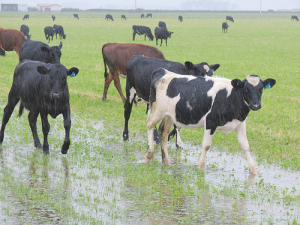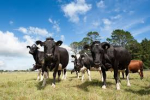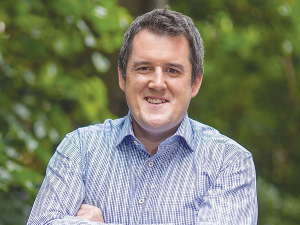An expert in dairy production systems says farmers now have more science based tools to help them deal with the very wet conditions occurring in many regions, but good farm management still has a big role.
Professor Danny Donaghy of Massey University says a lot of research on how to manage very wet farm conditions has been done by the uni, AgResearch, DairyNZ and Lincoln University.
Referring to feed profiles, he says it is not uncommon on a farm over a 12 month period to find two thirds of the feed comes from 40% of the paddocks. This points to the huge variation in production between paddocks onfarm, Donaghy says.
“Farmers know their good and bad paddocks, but they don’t necessarily always have figures for how good those good paddocks are. So when dealing with wet conditions, when grazing most paddocks is going to make a mess of them, we certainly don’t want to be stuffing up those areas that are producing two thirds of the feed on the farm.
“What it means is that we don’t have to take fantastic care of every paddock on the farm but there will be areas where we can’t afford to have bad pugging damage and miss 60% of production in the coming months,” he says.
He says farmers are now more experienced at managing droughts, and similar principles of farm management apply to managing very wet conditions.
“Some farms have low lying areas under water at this time of the year or too wet to get on without the cows making a helluva mess.
“Having an area that is more free draining and drier for the cows to go is important. It doesn’t have to be a sheltered barn; it could be a shelter belt of trees, a widened laneway with good drainage or part of the yards on the dairy. It could be paddocks on the farm with a different soil type that drain a lot better or are a bit more elevated and the cows can stand off on these areas,” he says.
Farms on heavy soil types like Massey Dairy 4 lend themselves to having mole and tile drains installed, Donaghy says. This allows the paddocks to shed water faster and recover quickly from heavy rain which in turn allows farmers to get cows and farm machinery back on paddocks faster.
Precision agriculture has brought with it excellent tools for measuring soil moisture -- tools used widely by farmers who have irrigation systems, but just as easily applied by farmers trying to manage wet conditions. By knowing the soil moisture levels, farmers can work out the best time to take cows off pasture and when to put them back on.
Traditionally NZ scientists have focused on breeding grass species that will withstand droughts, whereas in Ireland scientists have a focus on breeding grasses that deal with extreme wet conditions.
Donaghy says NZ is not at the point where it needs to go the Irish way. PGG Wrightson, AgResearch and Agriseeds are already exploring the ryegrass genome and are looking at species that will meet the different conditions around the country. He says something like the DairyNZ Forage Value Index evaluates the performance of different ryegrass cultivars in different parts of the country and is a useful tool.
“While it doesn’t necessarily specifically address the wet/dry areas it does look at the performance of those cultivars in different regions.”
To some degree farmers already choose pasture species that suit their conditions.
“Farmers will often plant fescue in lower lying areas or areas subject to flood damage because those grasses tend to handle wet conditions. Bromes don’t handle wet conditions or low oxygen soils well but they do better on drier soils, and cocksfoot does better on lower fertility soils and on drier soils.”
Good farm management also plays a big role in managing adverse events such as wet conditions.











